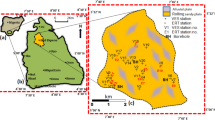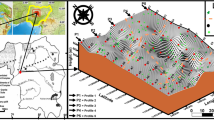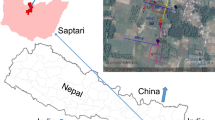Abstract
Geoelectrical resistivity technology (GRT) constrained by geological information was used to map the hydrokinetic properties, as well as the protectivity and potentiality of groundwater system in a medium-sized and sort after housing estate in Southern Nigeria. The GRT deployed involved Schlumberger 1-D vertical electrical resistivity sounding (VES) and 2-D electrical resistivity tomography (ERT). The primary and secondary geoelectric indices were used in tandem with existing geological information to estimate the hydrodynamic parameter maps of the shallowest aquifer unit, maximally exploited in the area for optimal management of the unconfined aquifer system beneath. Total porosity (0.282–0.691), specific yield (0.040–0.107), field capacity/specific retention (0.242–0.623) and storage-dependent drainability efficiency (SDE) (7.6–40.5%) were determined to depict the saturation dynamics in the study area. Results showed that the area has optimal release of pore water when the storage-dependent drainability efficiency is greater than 21%. The ensemble of potential index parameters such as transmissivity (57.4–4339.2 \(m^{2}\)/day), transverse resistance/aquifer potential scale (453.6–152,756.5 \(\Omega m^{2}\)), permeability (91.7–7269.7 mD) and hydraulic conductivity (57.4–4339.2 m/day) showed optimal potentiality but poor to moderate protectivity as evidenced by longitudinal conductance index (0.004–0.6218 Siemens). As many individuals have strong affinities to live in this fast, newly developed and competitive housing estate, it is a healthy practice that efficiently managed waste disposal arrangements/measures be put in place in order to ward off the exposure of leachates and other organic/inorganic wastes from permeating/draining into the already naturally vulnerable underlying hydrogeological units, where groundwater extracted for diverse use is stored.












Similar content being viewed by others
References
Akpan AE, Ugbaja AN, George NJ (2013) Integrated geophysical, geochemical and hydrogeological investigation of shallow groundwater resources in parts of the Ikom-Mamfe Embayment and the adjoining areas in Cross River State. Nigeria Environ Earth Sci 70(3):1435–1456. https://doi.org/10.1007/s12665-013-2232-3
Aweto KE (2011) Aquifer vulnerability assessment at Oke-Ila area. Southwestern Nigeria Int J Phys Sci 6(33):7574–7583
Bhatt K (1993) Uncertainty in wellhead protection area delineation due to uncertainty in aquifer parameter values. J Hydro 149(1–4):1–8
Braga ACO, Dourado JC, Malagutti Filho W (2006) Resistivity (DC) method applied to aquifer protection studies. Braz J Geophys 24(4):573–581
Dietrich S, Carrera J, Weinzettel P, Sierra L (2018) Estimation of Specific yield and its variability by electrical resistivity tomography. Water Resour Res. https://doi.org/10.1029/2018WR022938
Ekanem AM (2020) Georesistivity modelling and appraisal of soil water retention capacity in Akwa Ibom State University main campus and its environs, Southern Nigeria. Model. Earth Syst Environ. https://doi.org/10.1007/s40808-020-00850-6
Ekanem AM, George NJ, Thomas JE, Nathaniel EU (2019) Empirical relations between aquifer geohydraulic-geoelectric properties derived from surficial resistivity measurements in parts of Akwa Ibom State, Southern Nigeria. Nat Resour Res. https://doi.org/10.1007/s11053-019-09606-1
Frohlich RK, Kelly WE (1988) Estimates of specific yield with the geoelectric resistivity method in glacial aquifers. J Hydrology 97(1–2):33–44. https://doi.org/10.1016/0022-1694(88)90064-9
Frind O, Molson JW (2018) Issues and options in the delineation of well caapture zones under uncertainty. Groundwater 56(3):366–376. https://doi.org/10.1111/gwat.12644
Fetter CW (1988) Applied Hydrogeology. 2nd Edition, Merrill Publishing Company, Columbus, Ohio, p 592
Fetter CW (1994) Applied hydrogeology, 3rd edn. Macmillan College Publishing Company, New York
Gheorghe A (1978) Processing and synthesis of hydrological data. Abacus Press Junebridge Wells, Kent, pp 122–136
George NJ (2021) Geo-electrically and hydrogeologically derived vulnerability assessments of aquifer resources in the hinterland of parts of Akwa Ibom State, Nigeria. Solid Earth Sci. https://doi.org/10.1016/j.sesci.2021.04.002
George NJ, Emah JB, Ekong UN (2015) Geohydrodynamic properties of hydrogeological units in parts of Niger Delta, southern Nigeria. J Afr Earth Sci 105:55–63. https://doi.org/10.1016/j.jafrearsci.2015.02.009
George NJ, Ekanem AM, Thomas JE (2021) Ekong SA (2021) Mapping depths of groundwater-level architecture: implications on modest groundwater-level declines and failures of boreholes in sedimentary environs. Acta Geophys 69:1919–1932. https://doi.org/10.1007/s11600-021-00663-w
George NJ, Akpan AE, Akpan FS (2017) Assessment of spatial distribution of porosity and aquifer geohydraulic parameters in parts of the tertiary – quaternary hydrogeoresource of south-eastern Nigeria. NRIAG J Astron Geophys 6(2017):422–433
George NJ (2020) Appraisal of hydraulic flow units and factors of the dynamics and contamination of hydrogeological units in the littoral zones: a case study of Akwa Ibom State University and its Environs, Mkpat Enin LGA, Nigeria. Natural Resources Research. https://doi.org/10.1007/s11053-020-09673-9
George NJ, Obianwu VI, Obot IB (2011) Laboratory estimation of aquifer effective porosities from core samples obtained during borehole drilling in parts of the Niger Delta Region, South-eastern Nigeria. Adv Appl Sci Res Pelagia Res Libr 2(1):153–162
GSN (1962) Nigerian geological map series. Sheets 79 (Umuahia) and 82 (Calabar)
Hamill, L, Bell, FG (1986) Groundwater Resources Development. Butterworths Publications, p. 344
Hilberts A, Troch, Paniconi PC (2005) Storage-dependent drainable porosity for complex hillslopes, Water Resour Res 41 (6): 06001. https://doi.org/10.1029/2004WR003725
Ibanga JI, George NJ (2016) Estimating geohydraulic parameters, protective strength, and corrosivity of hydrogeological units: a case study of ALSCON, Ikot Abasi, Southern Nigeria. Arab J Geosci 9:363. https://doi.org/10.1007/s12517-016-2390-1
Ibuot JC, Akpabio GT, George NJ (2013) A survey of the repository of groundwater potential and distribution using geo-electrical resistivity method in Itu Local Government Area (LGA), Akwa Ibom State, southern Nigeria. Central Eur J Geosci 5(4):538–547
Ibuot JC, George NJ, Okwesili AN, Obiora DN (2019) Investigation of litho-textural characteristics of aquifer in Nkanu West Local Government Area of Enugu state, southeastern Nigeria. J Afr Earth Sci 153:197–207. https://doi.org/10.1016/j.jafrearsci.2019.03.004
Karadavut, S (2009) Potential and quality of surface water and ground water resources in Aksaray province and their assessment in terms of efficient irrigation. PhD Thesis, Namik Kemal University, Tekirdag, Turkey, 88 p (in Turkish with English abstract)
Karanath KR (1994) Hydrogeology. Mc Graw-Hill Publishing Co. Ltd, p. 458
King GE, Wildt PJ, O'Connell E (2003) Sand control completion reliability and failure rate comparison with a multi-thousand well database. Soc Petrol Eng. https://doi.org/10.2118/84262-MS
Loke MH, Acworth I, Dalhin T (2003) A comparison of smooth and blocky inversion methods in 2-D electrical imaging surveys. Explor Geophys 34:182–187
Loke MH, Barker RD (1996) Rapid least-squares inversion of apparent resistivity pseudosections by a quasi-Newton method. Geophys Prospect 44:131–152
Loke MH, Dalhin T (2002) A comparison of the Gauss-Newtonand quasi-Newton methods in resistivity imaging inversion. J App Geophy 49:149–462
Mazac O, Kelly WE, Landa I (1985) A Hydrogeophysical model for relation between electrical and hydraulic properties of aquifers. J Hydrol 79:1–19
Nielsen P, Perrochet P (2000) Watertable dynamics under capillary fringes: experiments and modelling. Adv Water Resour 23:503–515
Niwas S, Singhal DC (1985) Aquifer transmissivity of porous-media from resistivity data. J Hydrol 82(1–2):143–153
Niwas S, Tezkan B, Israil M (2011) Aquifer hydraulic conductivity estimation from surface geoelectrical measurements for Krauthausen test site, Germany. Hydrol J 19(2):307–315
Obinawu VI, George NJ. Udofia KM (2011) Estimation of aquifer hydraulic conductivity and effective porosity distributions using laboratory measurements on core samples in the Niger Delta, Southern Nigeria. International Review of Physics, Praise Worthy Prize, Italy 5 (1):19–24
Obiora DN, Ibuot JC, George NJ (2015) Evaluation of aquifer potential, geoelectric and hydraulic parameters in Ezza North, southeastern Nigeria, using geoelectric sounding. Int J Sci Technol. https://doi.org/10.1007/s13762-015-0886-y
Oladapo MI, Mohammed MZ, Adeoye OO, Adetola BA (2004) Geo-electrical investigation of the Ondo state housing corporation estate Ijapo Akure, Southwestern Nigeria. J Mining Geol 40(1):41–48
Omosuyi GO (2010) Geo-electric assessment of groundwater prospect and vulnerability of overburden aquifers at Idanre, Southwestern Nigeria. Ozean J Appl Sci 3(1):19–28
Onu N (2003) Estimates of the relative specific yield of aquifers from geo-electrical sounding data of the coastal plains of southeastern Nigeria. J Technol Educ Nigeria 8(1):69–83. https://doi.org/10.4314/joten.v8i1.35641
Petters SW (1982) Central West African cretaceous—tertiary benthic foraminifera and stratigraphy. Paloeontograph A 179:1–104
Petters SW (1989) Akwa Ibom State: physical background, soil and landuse and ecological problems. Technical Report for Government of Akwa Ibom State, pp 603
Schwartz FW, Zhang H (2003) Fundamentals of Groundwater. Willey, New York, p 574
Shamsudduha M, Taylor R, Longuevergne L (2012) Monitoring groundwater storage changes in the highly seasonal humid tropics: validation of GRACE measurements in the Bengal Basin. Water Resour Res 48:W02508. https://doi.org/10.1029/2011WR010993
Short KC, Stäuble AJ (1965) Outline of geology of Niger Delta. Am Asso Petrol Geol Bull 51:761–779
Short KC, Stauble AJ (1967) Outline of the geology of Niger Delta. Assoc Pet Geol Bull 54:761–779
Samouëlian, Cousin I, Tabbagh A, Bruand A, Richard G (2005) Electrical resistivity survey in soil science: a review. Soil Tillage Res 83(2):173–193. https://doi.org/10.1016/j.still.2004.10.004
Sri N, Muhammed C (2012) Equation estimation of porosity and hydraulic conductivity of Ruhrtal aquifer in Germany using near surface geophysics. J Appl Geophys 84(2012):77–85
Stempvoort DV, Ewert L, Wassenaar L (1993) Aquifer vulnerability index: a GIS—compatible method for groundwater vulnerability mapping. Canad Water Resour J 18(1):25–37
Thomas JE, George NJ, Ekanem AM, Nsikak EE (2020) Electrostratigraphy and hydrogeochemistry of hyporheic zone and water-bearing caches in the littoral shorefront of Akwa Ibom State University, Southern Nigeria. Environ Monit Assess 192:505. https://doi.org/10.1007/s10661-020-08436-6
Tizro AT, Voudouris K, Basami Y (2012) Estimation of porosity and specific yield by application of geoelectrical method–a case study in western Iran. J Hydrol 454–455:160–172. https://doi.org/10.1016/j.jhydrol.2012.06.009
Tizro AT (2002) Bulletin of the geological society of Malaysia. 45:37–41. https://doi.org/10.1016/j.still.2004.10.004
Todd DK (1980) Groundwater Hydrology. Wiley, New York, p 535
Tripp AC, Hohmannt GW, Swift CM Jr (1984) Two-dimensional resistivity inversion. Geophys 49(10):1708–1717
Vander Velpen BPA, Sporry RJ (1993) Resist: a computer program to process resistivity sounding data on PC compatibles. Comput Geosci 19(5):691–703
Vázquez-Báez V, Rubio-Arellano A, García-Toral RM, I. (2019) Modeling an aquifer numerical solution to the groundwater flow equation. Math Probl Eng. https://doi.org/10.1155/2019/1613726
Zhaoyang L, Shen C, Kong J, Hua G, Gao X, Zhongwei Z, Zhao H, Li L (2018) Effects of unsaturated flow on Hillslope recession characteristics. Water Resour Res 54:2037–2056. https://doi.org/10.1002/2017WR022257
Zohdy AAR (1989) A new method for automatic interpretation of Schlumberger and Wenner sounding curves. Geophysics 5(2):245–252
Zohdy AAR, Eaton GP, Mabey DR (1974) Application of surface Geophysics to groundwater investigations. US Geological Survey Techniques of Water- Resources Investigations, Book 2. p. 116 (Chapter D1)
Acknowledgements
We are grateful to the reviewers and the editor whose comments have reformed the manuscript for enhanced contextual improvement. The authors are indebted to their colleagues in Geophysics Research Group (GRG) of Akwa Ibom State University for their assistance during the field data acquisition and editing of the manuscript. We equally thank TETfund who sponsored the first author through staff development of Akwa Ibom State Polytechnic, Ikot Osurua.
Funding
The project was funded by the TETfund through staff development of the first author, a staff from Akwa Ibom State Polytechnic, Ikot Osurua.
Author information
Authors and Affiliations
Corresponding author
Ethics declarations
Conflict of interest
The authors declare that they have no known competing financial interests or personal relationships that could have appeared to influence the work reported in this paper.
Human and animal rights
This article does not contain studies with human or animal subjects.
Additional information
Edited by Dr. Michael Nones (CO-EDITOR-IN-CHIEF).
Rights and permissions
About this article
Cite this article
Ekanem, K.R., George, N.J. & Ekanem, A.M. Parametric characterization, protectivity and potentiality of shallow hydrogeological units of a medium-sized housing estate, Shelter Afrique, Akwa Ibom State, Southern Nigeria. Acta Geophys. 70, 879–895 (2022). https://doi.org/10.1007/s11600-022-00737-3
Received:
Accepted:
Published:
Issue Date:
DOI: https://doi.org/10.1007/s11600-022-00737-3




